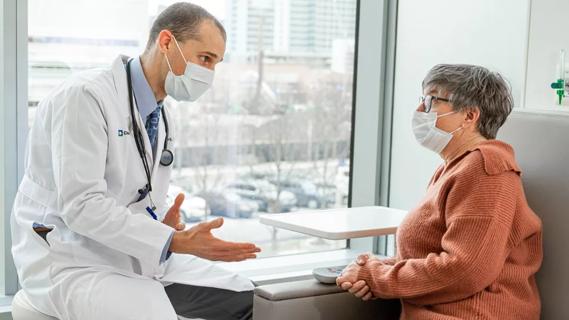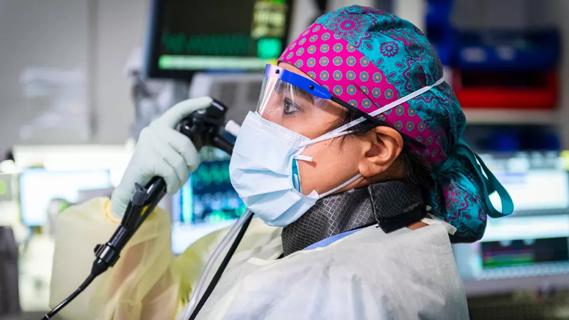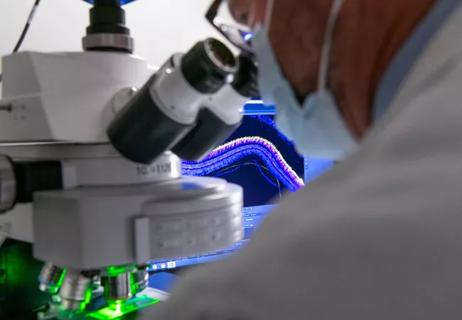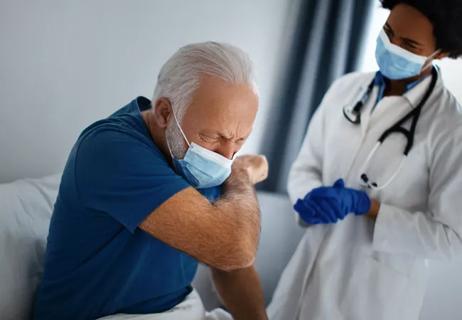Advances in diagnosis and treatment

Cleveland Clinic is a non-profit academic medical center. Advertising on our site helps support our mission. We do not endorse non-Cleveland Clinic products or services. Policy
Inhalation of beryllium (Be) has been associated with acute and chronic lung disease. Due to improved industrial hygiene measures, acute beryllium disease has essentially disappeared, but chronic beryllium disease (CBD) continues to affect workers in industries where beryllium is manufactured and processed.
CBD represents a delayed-type hypersensitivity reaction to beryllium and is clinically similar to other granulomatous diseases, such as sarcoidosis. While most beryllium exposure occurs through inhalation, and the lung is the primary organ involved in CBD, exposure can also occur through the skin or mucous membranes. Developing beryllium immune sensitization and overt disease depends on several factors including genetics and type of exposure. Generally, about 10 percent of exposed individuals develop beryllium sensitization, and about 50 percent of sensitized individual (5 percent of all exposed) develop CBD.
Occupations with the highest potential for exposure are those involved with primary production, metal machining and reclaiming scrap alloys. Other high exposure areas are in the nuclear power, aerospace and electronics industries. The disease has been reported in individuals with very low exposure (e.g., administrative assistants) who are not involved in the manufacturing process. This may be a reflection of genetic predisposition, which seems to have a major role in the development of CBD. A variant of the major histocompatibility complex (HLA-DP1(Glu69)) was found in 97 percent of patients with CBD and only in 30 percent of controls.
The clinical history (other than the occupational history) and physical examination are usually nonspecific. The blood beryllium lymphocyte proliferation test is currently the screening test of choice to identify workers who develop beryllium sensitization or CBD. This test is also currently an integral part of the diagnosis of CBD. The test involves exposing peripheral blood mononuclear cells in vitro to beryllium salts at varying concentrations for variable time intervals. Cell proliferation in the presence of beryllium indicates a positive test. Cleveland Clinic has one of the few laboratories around the country that can run this highly specialized test.
On pulmonary function testing, spirometry may show evidence of obstruction, restriction or both. The diffusing lung capacity usually declines over the course of the disease. A chest radiograph is normal in more than half of the patients who are eventually confirmed to have CBD based on lung pathology. High resolution chest CT is more sensitive than the chest radiograph but can still be normal in more than 25 percent of patients with CBD. Typical findings on high resolution CT are ground glass opacities or interstitial changes.
Flexible fiberoptic bronchoscopy with bronchoalveolar lavage (BAL) and transbronchial biopsies are usually necessary to confirm a suspected diagnosis of CBD. Typical findings on bronchoscopy include BAL lymphocytosis (more than 20 percent lymphocytes). The beryllium lymphocyte proliferation test can also be performed on BAL cells.
To diagnose CBD, the following two criteria must be satisfied: a positive blood or BAL beryllium lymphocyte proliferation test, and the presence of non-necrotizing granulomas (or other compatible pathology) on lung biopsy. Patients who have a positive blood beryllium lymphocyte proliferation test but normal lung pathology are considered to be sensitized to beryllium but do not have CBD. Sensitized individuals have a lifelong risk for developing the disease and require periodic monitoring.
Due to the use of the beryllium lymphocyte proliferation test to screen workers exposed to beryllium, many cases are now diagnosed very early, before radiographic or physiologic changes are seen and symptoms develop. The natural history of the disease is not clear in patients who have granulomas on transbronchial biopsy but are asymptomatic with no physiologic or radiographic abnormalities. For many individuals, the disease may not progress beyond asymptomatic granulomas in the lungs. For some, the granulomas become organized and eventually cause fibrosis, resulting in progressive impairment of pulmonary function.
No controlled studies for CBD therapy are available. Based on the pathogenesis of the disease (immune-mediated) and given the similarities to sarcoidosis, CBD is treated with corticosteroids. In end-stage cases, lung transplantation may be considered.
Cleveland Clinic has been and continues to be on the forefront of evaluating and caring for patients with beryllium-induced lung disease, investigating their problems and educating healthcare professionals about beryllium disease related issues. Some program highlights include:
Cleveland Clinic remains one of only a few referral centers in the United States to offer comprehensive evaluation for individuals with beryllium exposure, beryllium sensitization and CBD including full-service, onsite beryllium lymphocyte proliferation testing on blood and BAL.
To refer a patient, please contact Dr. Raed Dweik at 216.445.5763.
Dr. Dweik is staff in the departments of Pulmonary and Critical Care Medicine and Pathobiology.
Suggested reading:
Balmes JR, Abraham JL, Dweik RA, et al; ATS Ad Hoc Committee on Beryllium Sensitivity and Chronic Beryllium Disease. An official American Thoracic Society statement: diagnosis and management of beryllium sensitivity and chronic beryllium disease. Am J Respir Crit Care Med. 2014;190(10):e34-59.
Amicosante M, Berretta F, Dweik R, Saltini C. Role of high-affinity HLA-DP specific CLIP-derived peptides in beryllium binding to the HLA-DPGlu69 berylliosis-associated molecules and presentation to beryllium-sensitized T cells. Immunol. 2009;128(1 Suppl):e462-470.
Culver DA and Dweik RA. Chronic beryllium disease. Clin Pulm Med. 2003;10:72-79.
Barna BP, Culver DA, Yen-Lieberman B, Dweik RA, Thomassen MJ. Clinical application of beryllium lymphocyte proliferation testing. Clin Diagn Lab Immunol. 2003;10:990-994.
Barna BP, Dweik RA, Farver CF, Culver D, Yen-Lieberman B, Thomassen MJ. Nitric oxide attenuates beryllium-induced IFNgamma responses in chronic beryllium disease: evidence for mechanisms independent of IL-18. Clin Immunol. 2002;103:169-175.

A review of IDSA and NIH guidelines

Caregivers are provided with real-time bronchoscopy patient findings

New program sets out to better support underserved patient populations

As the U.S. has seen an increase in respiratory-related morbidity and mortality, supporting future respiratory researchers has become imperative

Diagnosing the cause of a chronic cough can be challenging and timely, but multidisciplinary collaboration and the development of new treatments are improving the process

Despite a decline in numbers, the demand for respiratory therapists continues to rise

A mindset shift has changed the way pulmonologists both treat and define PFF

Will enable patients with long COVID to enroll in national clinical trials